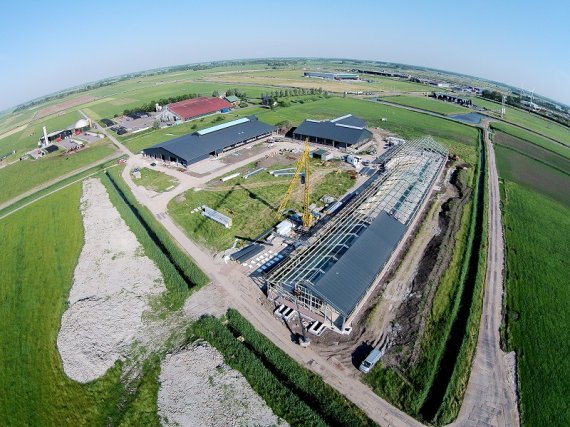The new sheds contain several units in which innovative research is done in collaboration with companies in the dairy sector, Livestock Research and education. In the new environmental shed, for example, research is done on whether a fl oor affects ammonia emissions. The feed research shed boasts feeding troughs which can register each individual cow’s eating habits and behaviour. One of the things which can then be measured is the impact of the feed on the cow’s milk production. Next year another two innovative sheds will go up at the Dairy Campus, each housing 60 cows. The cows which are now still at the Waiboerhoeve dairy farm in Lelystad will be transferred to Leeuwarden in stages. This will create a dairy farm with a total herd of 550 cows. A mega-farm, admits Dairy Campus spokesperson Nelleke Meindertsma. ‘But it is really a concentration of research and practical learning facilities.’ The current shed on the Dairy Campus, formerly experimental farm Nij Bosma Zathe, houses 180 cows. In future this shed will be used for hands-on classes.
The Dairy Campus attracts about 10,000 visitors a year
The expansion has advantages for the implementation of innovative research, explains Meindertsma. ‘Because of the regulations and the amount of space available in the Netherlands it is not easy for dairy farmers to expand. So there is a need for innovation in the fi eld of livestock, pasturing, animal health, sensor technology and manure processing.’ A grazing study with a large number of cows is currently under way. ‘The aim is to gain more knowledge so as to make optimal use of a lot for grazing.
As well as the new sheds, there will also be a new reception area. About 10,000 people visit the Dairy Campus every year. Meindertsma: ‘It should be a meeting place and a living lab for companies and knowledge institutions.’ The building and the implementation represent an investment of about 40 million over a period of ten years, which also covers an innovation and education programme. Twelve research programmes have been launched since the start of the innovation programme in March last year. The companies working on these programmes can be refunded for some of the costs from a special innovation fund. One example is an ongoing study backed by this fund which measures the effect of fertilizer with air bubbles on ammonia and greenhouse gas emissions. The education programme consists of three posts at Van Hall Larenstein University of Applied Sciences focussing on the development and communication of knowledge on a profi table and sustainable dairy industry.
Photo: Dairy Campus




